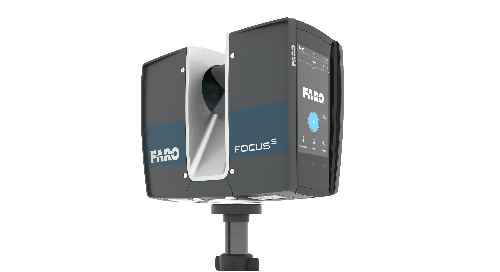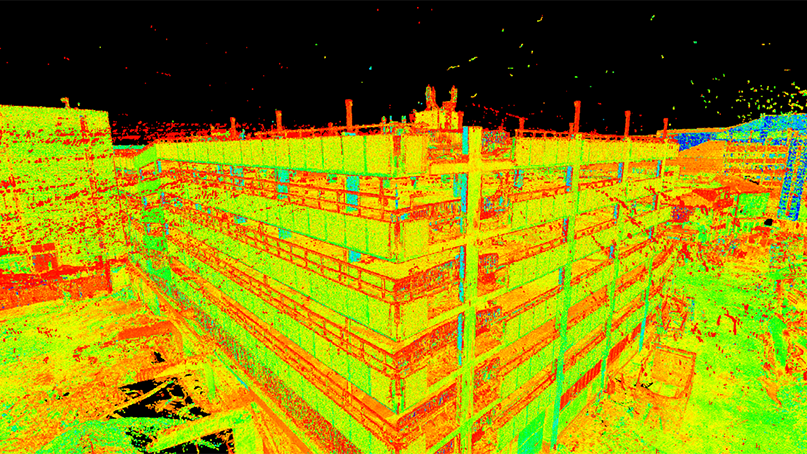New Methods to Use 3D Scanning in Concept Development
Wiki Article
The Future of Precision Dimension: Understanding the Role of 3D Laser Scanning Innovation
The landscape of precision measurement is evolving with the advent of 3D laser scanning modern technology. This technology assures improved accuracy and effectiveness across different industries. As industries begin to embrace these improvements, the implications for job administration and execution come to be increasingly considerable. The transformative effects of this innovation expand beyond simple numbers and dimensions, hinting at a broader shift in exactly how specialists approach their job. What might this imply for the future?What Is 3D Laser Scanning Modern Technology?
3D laser scanning innovation is a sophisticated method utilized to record exact three-dimensional dimensions of physical objects and atmospheres. This modern technology utilizes laser beams to gather data points, which are then refined to create thorough digital depictions of the scanned subjects. By giving off thousands of laser pulses per secondly, 3D laser scanners can properly tape-record the form, size, and spatial partnerships of various surface areas.The procedure generally includes placing the scanner at different vantage factors to record considerable information. The resulting point cloud, a collection of countless data points, can be examined and exchanged 3D models. Applications of this modern technology period multiple areas, including heritage, style, and design conservation, where it helps in documentation and evaluation. As a non-intrusive technique, 3D laser scanning reduces interruption to the atmosphere, permitting for detailed evaluations of both existing frameworks and natural landscapes, therefore enhancing understanding and helping with informed decision-making.
Secret Benefits of 3D Laser Scanning in Various Industries
3D laser scanning innovation uses considerable benefits throughout numerous sectors by supplying boosted accuracy and precision in measurements. This technology not just simplifies workflows yet likewise results in substantial time and cost savings. As companies progressively embrace this innovative technique, the advantages come to be noticeable in boosted project outcomes and efficiencies.Enhanced Accuracy and Precision
The assimilation of laser scanning modern technology has transformed the method markets approach measurement and information collection. This technology offers an extraordinary degree of accuracy, catching numerous information factors in a solitary scan. As a result, professionals throughout different fields, such as engineering, style, and manufacturing, can develop very outlined 3D versions that mirror real-world conditions. Boosted precision minimizes errors related to standard measurement approaches, making sure that layouts and building and constructions are based on exact data. Additionally, the capacity to capture intricate details enables for better evaluation and decision-making, eventually leading to boosted results. By leveraging 3D laser scanning, industries can attain higher standards of high quality, making it an important device for accurate measurements.Time and Expense Performance
Efficiency in time and price is a substantial advantage supplied by laser scanning innovation, changing task execution throughout numerous markets. By quickly recording comprehensive 3D information, laser scanning minimizes the moment spent on hands-on measurements and reduces the risk of mistakes. This swift data acquisition helps with much faster decision-making and task timelines, enabling groups to assign sources better. Furthermore, the modern technology lowers the demand for rework, as accurate designs cause better planning and execution. Industries such as building, design, and producing benefit considerably, seeing lower prices related to labor and products. Generally, 3D laser scanning not just improves functional efficiency however additionally adds to significant cost savings, making it a vital device in today's affordable landscape.Applications of 3D Laser Scanning in Design and Building and construction
As building and building and construction tasks expand increasingly complicated, the adoption of laser scanning technology has actually emerged as a transformative service. This innovation supplies precise measurements and comprehensive 3D representations of existing frameworks, facilitating more precise preparation and style procedures. Designers make use of 3D laser scanning to create electronic designs that capture elaborate information, guaranteeing that improvements and new constructions straighten perfectly with existing problems.

The Role of 3D Laser Scanning in Manufacturing Processes
3D laser scanning plays a necessary duty in making processes by enhancing high quality control with specific measurements and data collection. This technology permits suppliers to identify discrepancies early, minimizing errors and waste. Furthermore, it enhances production workflows by promoting far better communication and control amongst teams.Boosted High Quality Control
Quality control in making procedures has actually been revolutionized go to my blog by the combination of laser scanning modern technology. This ingenious strategy permits exact dimensions and in-depth evaluations of parts, ensuring that they fulfill rigid quality requirements. 3D laser scanning captures elaborate geometries and tolerances, enabling makers to find inconsistencies from design requirements swiftly. This innovation greatly lowers human error related to standard measurement techniques, providing dependable and consistent information. By helping with real-time quality control, it makes it possible for positive changes in the production process, ultimately leading to boosted item integrity and customer fulfillment. As sectors increasingly adopt 3D laser scanning, the capacity for enhanced quality control becomes apparent, noting a transformative change in manufacturing methods.Structured Production Process
Reliable manufacturing operations are significantly taking advantage of the assimilation of laser scanning innovation in manufacturing procedures. This technology enables quick, accurate measurements of assemblies and components, considerably lowering the moment required for setup and modifications. By capturing specific geometry, manufacturers can swiftly determine disparities in between style specifications and actual items, enabling instant corrective activities. Furthermore, 3D laser scanning facilitates the seamless transfer of information in between style and manufacturing teams, enhancing collaboration and lowering mistakes. The technology additionally supports electronic twin development, permitting real-time tracking and optimization of producing processes. Therefore, companies can attain higher efficiency, decreased waste, and boosted general performance, inevitably driving competitive advantage in the market.Protecting Heritage: Exactly How 3D Laser Scanning Aids Cultural Conservation
As social heritage websites encounter the risk of degeneration and devastation, innovative technologies such as laser scanning become crucial devices for preservation initiatives. 3D laser scanning catches detailed details of historic structures and artifacts with exceptional precision, developing electronic versions that offer several purposes in preservation. These designs permit precise paperwork of present conditions, allowing experts to check modifications in time and analyze wear and tear dangers.Additionally, laser scanning assists in online restoration, assisting conservators create prepare for repairs or recreating lost elements without intrusive methods. The technology also assists in informing the general public, providing immersive experiences via digital scenic tours that highlight the importance of these sites. By incorporating 3D laser scanning right into social preservation techniques, stakeholders can assure that heritage is maintained for future generations while boosting understanding and gratitude of historical contexts.
The Future Outlook: Innovations and Patterns in 3D Laser Scanning Modern Technology
Though 3D laser scanning innovation has actually currently transformed different markets, its future guarantees even higher developments that will improve access, precision, and rate. Arising patterns suggest a boost in assimilation with expert system and maker learning, causing smarter information handling and evaluation abilities. This synergy will certainly allow quicker decision-making and more accurate results in fields such as heritage, engineering, and building conservation.Moreover, innovations in hardware are expected to yield lighter, much more mobile scanning devices, equalizing accessibility for smaller companies and individual professionals - 3D Scanning. As software application proceeds to develop, easy to use applications will streamline complex operations, making 3D scanning a lot more available to non-experts
The increase of cloud-based services will certainly facilitate real-time cooperation and information sharing amongst stakeholders, leading the way for structured project administration. Collectively, these fads signal a future where 3D laser scanning modern technology comes to be an essential tool in an even wider range of applications.
Often Asked Inquiries
Just How Much Does 3D Laser Scanning Modern Technology Expense?

What Are the Skills Needed to Run 3D Laser Scanners?
Running 3D laser scanners requires technical effectiveness, focus to information, spatial awareness, knowledge of software program for data handling, and an understanding of surveying principles. Furthermore, strong analytic capabilities and logical abilities are vital for reliable procedure.Can 3D Laser Scanning Integrate With Other Technologies?
Yes, 3D laser scanning can incorporate seamlessly with other modern technologies, such as Geographic Details Equipment (GIS), Structure Information Modeling (BIM), and enhanced truth, improving data precision and helping with better analysis across numerous markets and applications. - 3D ScanningWhat Is the Regular Scanning Array of These Tools?
The normal scanning series of 3D laser scanning tools differs widely, generally in between 50 meters to over 1,000 meters, depending upon the design and application, affecting image source their suitability for different precision dimension jobs and environments.How Lengthy Does a 3D Laser Scanning Project Take?
A 3D laser scanning task commonly takes anywhere from a couple of hours to numerous days, relying on elements such as task size, intricacy, and required detail. Each job's timeline can vary substantially based on these components.The landscape of precision dimension is advancing with the introduction of 3D laser scanning modern technology. 3D laser scanning modern technology is an advanced approach utilized to catch exact three-dimensional measurements of physical items and atmospheres. 3D laser scanning technology uses considerable advantages across various sectors by providing improved accuracy and precision in dimensions. 3D laser scanning innovation has already changed different markets, its future guarantees also higher developments that will certainly enhance availability, speed, and accuracy. 3D laser scanning technology typically costs between $10,000 and $100,000, depending on the tools's capacities and functions.
Report this wiki page